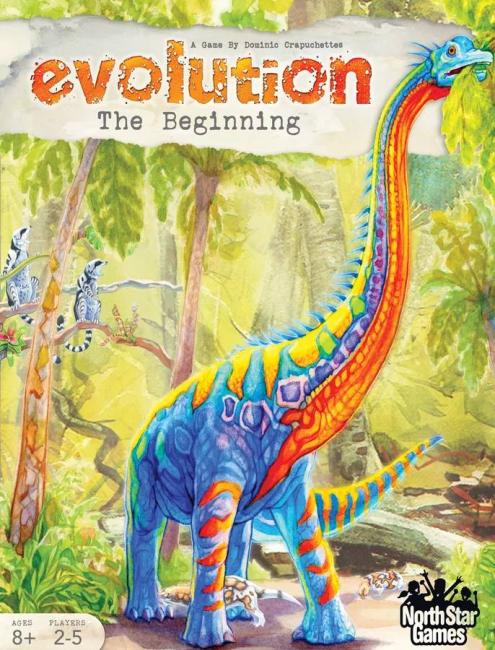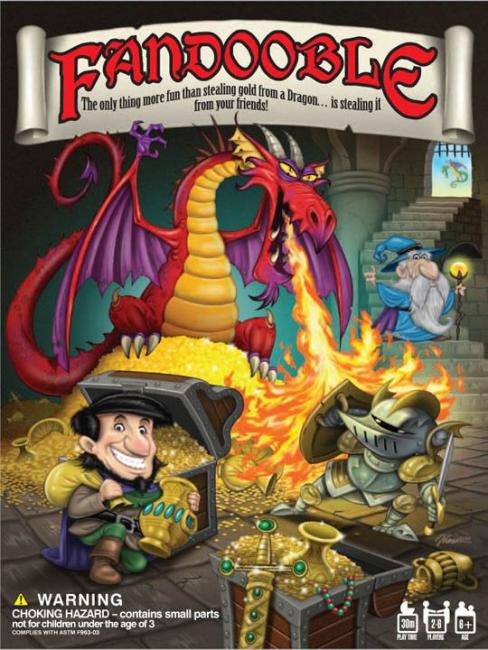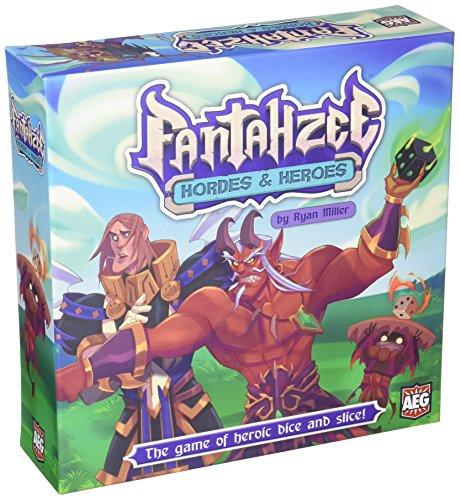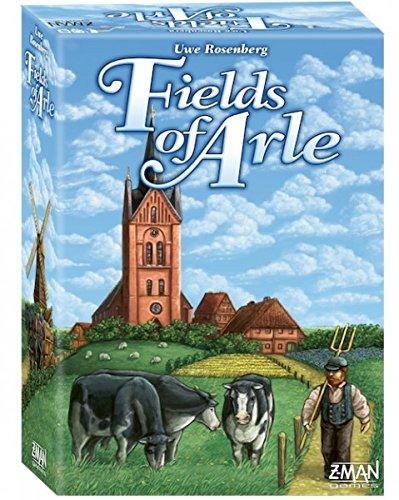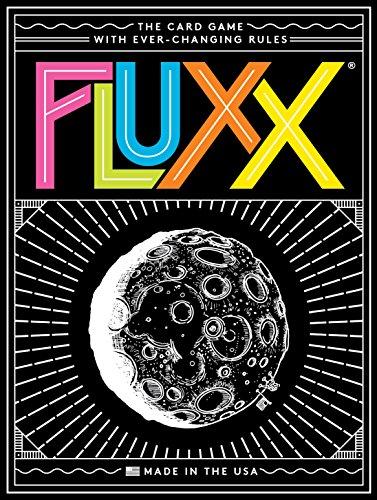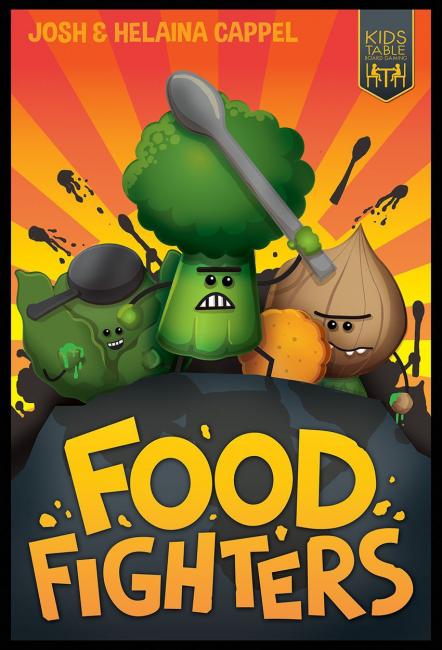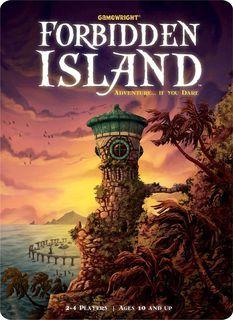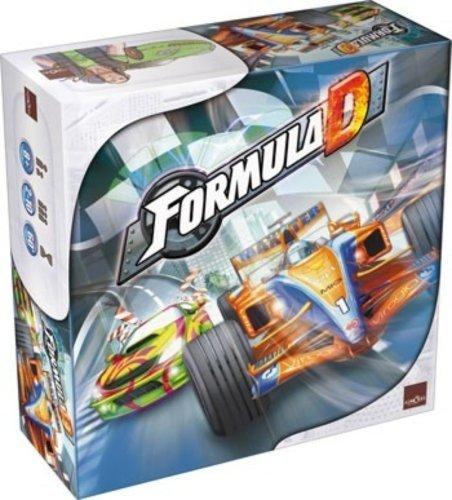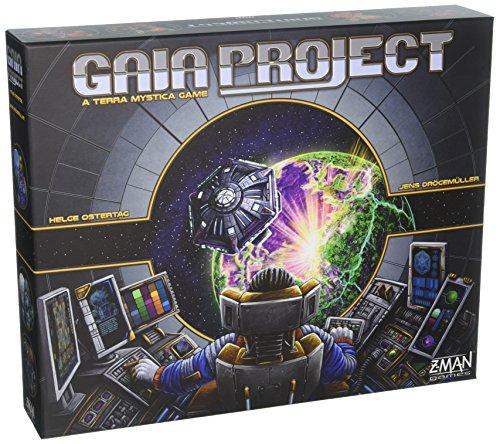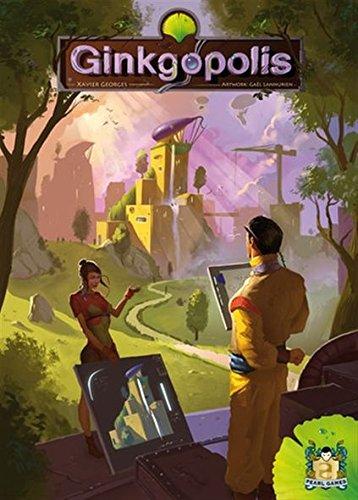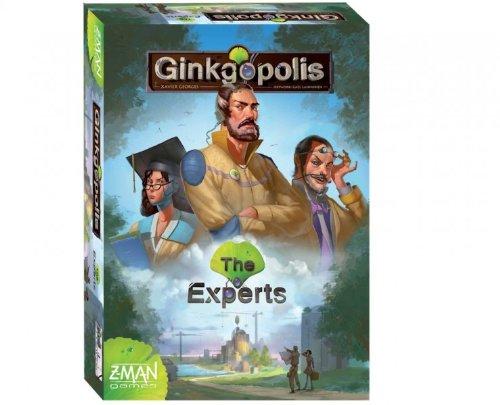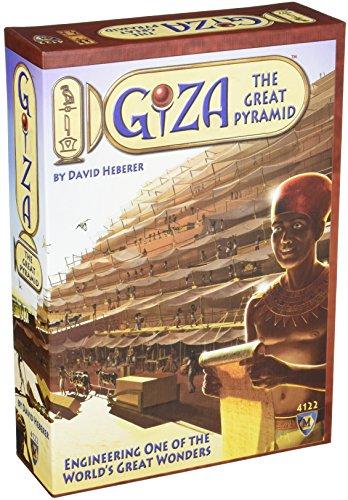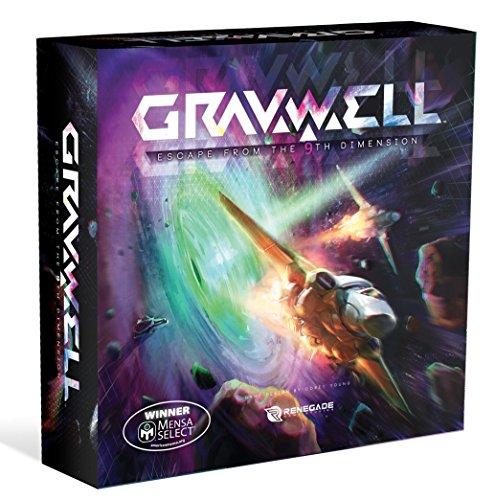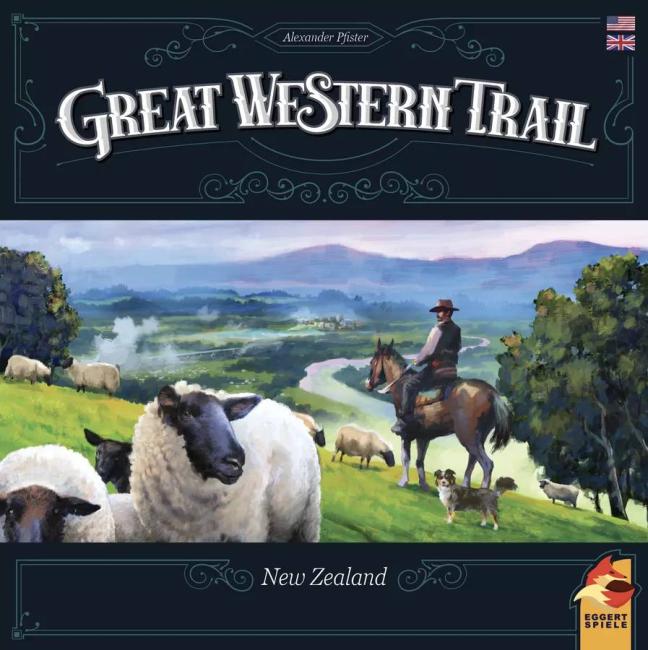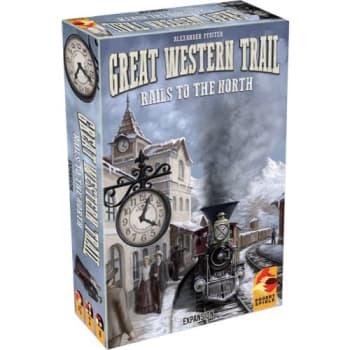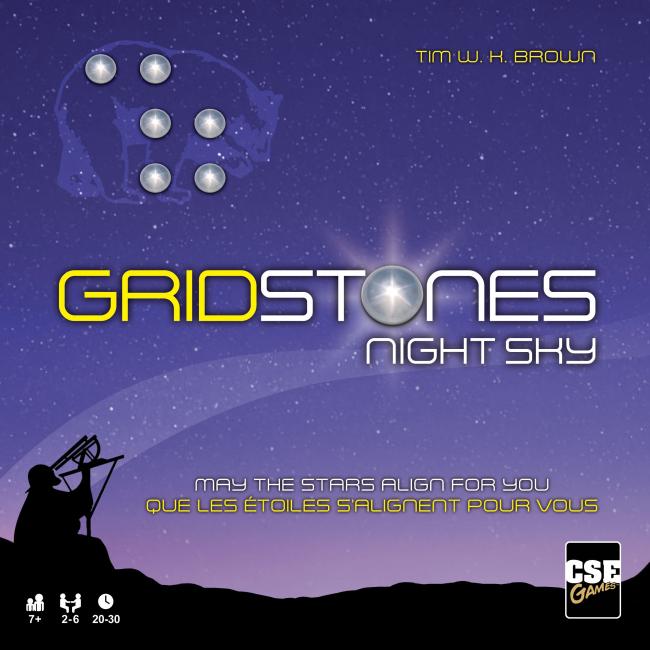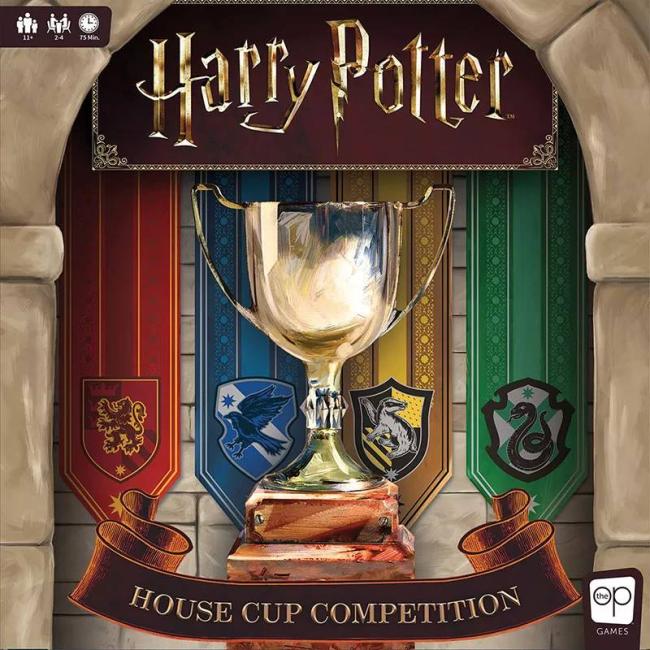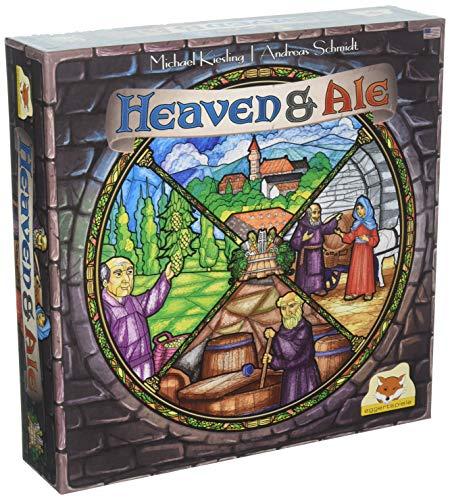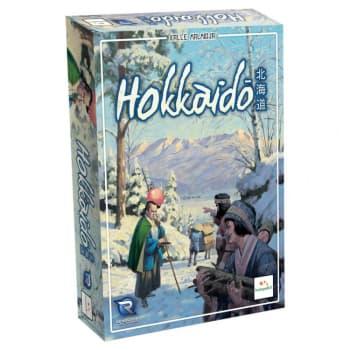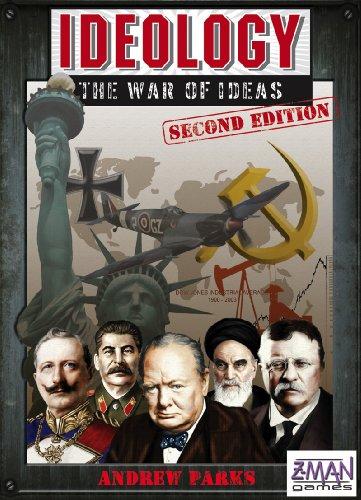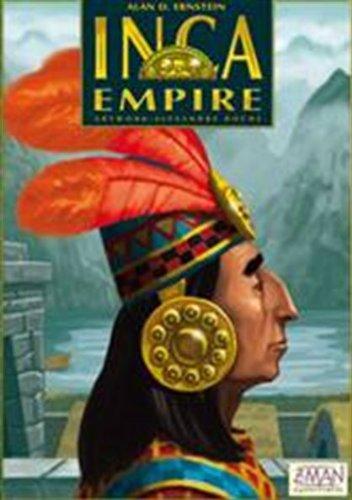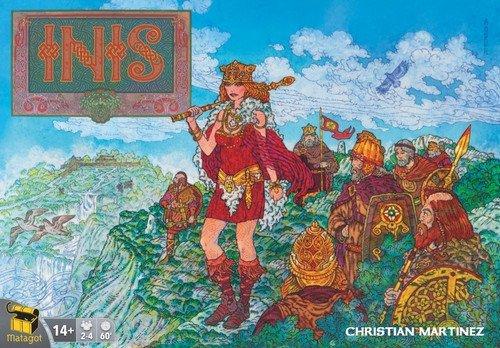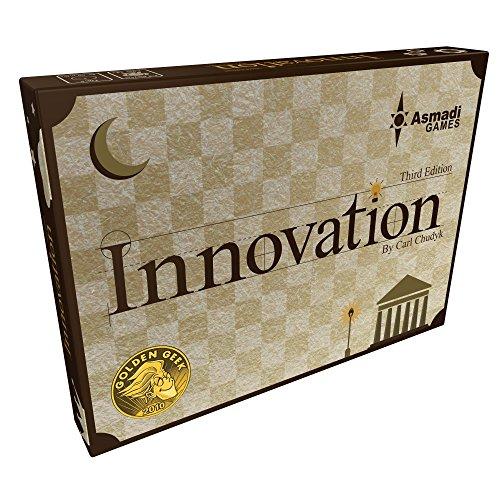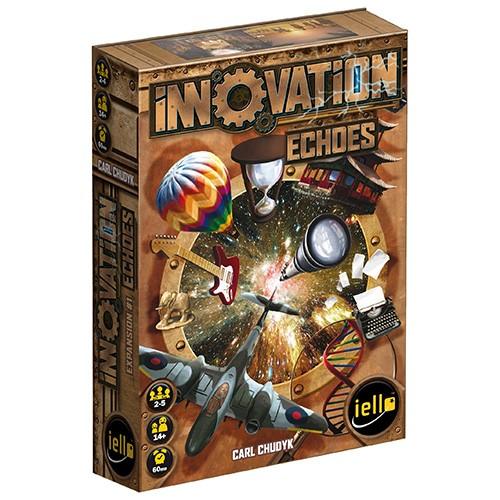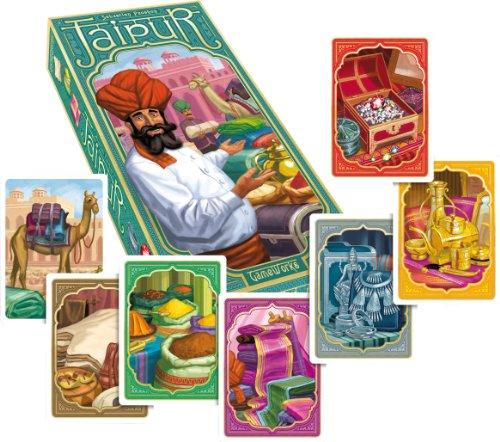
|
Evolution: The Beginning
In Evolution: The Beginning, you'll adapt your species to succeed in a dynamic ecosystem where food is scarce and predators roam. Traits like Flight and Horns will protect your species from Carnivores while a Long Neck will help them get food that others cannot reach. With hundreds of ways to evolve your species, every game unfolds in a beautifully unique way.
Evolution: The Beginning borrows ideas and concepts from other games in the Evolution branded product line, but it is a stand-alone game that is not compatible with anything else in the Evolution product line. It is the most casual and quick playing adaptation of the Evolution concept, but it is highly strategic as a two-player game.
Minimum Age: 8
Minimum Players: 2
Maximum Players: 5
Boardgame Atlas: Link
|
North Star Games |
Animals, Card Game, Prehistoric |
2016 |
1 |

|
Fandooble
Fandooble is a wildly fun and fast party game. Race against your opponents to steal all of the gold from the fearsome dragon. Wizards and knights will help you along the way, but your never know when they'll show up.
Keep and eye on that rascally scoundrel Fandooble though; he'll steal your hard stolen gold and give it to someone else before you can say, "Don't steal my gold, rascally scoundrel Fandooble."
Watch out, though – roll three dragons and you lose the gold you just stole; roll three red fire-breathing dragons, and you are really out of luck!
Minimum Age: 8
Minimum Players: 2
Maximum Players: 6
Boardgame Atlas: Link
|
Mindtwister USA |
Fantasy |
2011 |
1 |

|
Fantahzee: Hordes & Heroes
Gather up a team of heroes in Fantahzee: Hordes & Heroes to defend the town, roll the combinations to activate their awesome abilities, and fight your way through the monsters to the bosses. Defeat three of the five bosses, then tally up your trophies from the day. Collect the most VP to win!
"Mages, warriors, dwarves, and their fantastical contraptions, all call Devil's Burden home. But in a town with that name, you know trouble can't be far away, and today things just got serious! Hordes of monsters have attacked. The Town needs leaders to bring its heroes together to defeat the dread generals and their armies.
Play your cards right, and roll with the luck of the dice, and you may be hailed as the savior of the town in this game of cards and combinations for 2-5 players brought to life throughthe art of J Hause."
Minimum Age: 14
Minimum Players: 2
Maximum Players: 5
Boardgame Atlas: Link
|
Alderac Entertainment Group |
Dice, Fantasy, Fighting |
2016 |
1 |

|
Fantasy Fantasy Baseball
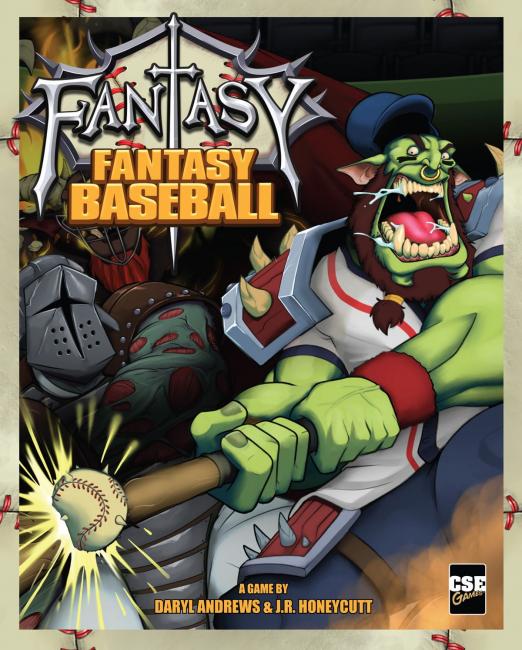
In Fantasy Fantasy Baseball, you are the Wizard manager of a baseball team of fantasy creatures going through a season of fantasy baseball. Go head-to-head against other Wizard managers and battle for wins while building up your team’s statistics. But beware, your players may be sent on missions or have spells cast on them.
Developed by acclaimed designers Daryl Andrews and J.R. Honeycutt with art by Rob Lundy, Fantasy Fantasy Baseball is a roster-building card game that requires you to draft a strong team, manage your roster, deal with events and use your players’ special abilities.
Fantasy Fantasy Baseball weaves together all the best elements of fantasy baseball, including head-to-head win system and rotisserie stat tracking. However, instead of the typical fantasy sports experience taking months to play, the entire experience is boiled down to 10 minutes per player. Also, the amazing fantasy creatures help make this game accessible and fun for baseball fans and gamers to enjoy together.
Minimum Age: 10
Minimum Players: 1
Maximum Players: 5
Boardgame Atlas: Link
|
CSE Games |
Card Game, Fantasy, Sports |
2017 |
1 |

|
Fields of Arle
In the small East Frisian village of Arle on the verge of the 18th century, your family must take care of numerous tasks: dehydrate the moot, plow the farmland, and breed the animals. Improving your craftsmanship in the village and constructing the appropriate buildings will be invaluable.
Turn by turn, assign various tasks to the members of your family while keeping an eye open for the changing seasons. Use your vehicles to trade resources with others and upgrade your goods.
The fields of Arle await you!
Minimum Age: 13
Minimum Players: 1
Maximum Players: 2
Boardgame Atlas: Link
|
Z-Man Games |
Economic, Farming, Industry/Manufacturing |
2014 |
1 |

|
Fired Up

In the near future, entertainment will have changed. It will have evolved beyond traditional sports in stadiums and into a larger than life spectacle where digital warriors will compete against one another inside the cyberspace arena in bloodless conflict sports.
In this futuristic environment is where Fired Up is set. In the game the players are not the fighters! They are spectators with premium seats to the largest spectacle of all time. Their premium seats make it possible for them to influence the digital athletes in the Arena and bet on their champions in the fight.
Each round the players roll dice to determine how best to influence the warriors and will secretly bet on specific highlights they would like to see happening, thus having the best time ever! During the course of the game, each player roll their action dice which can be used to influence the fighters. After the action selection phase, the fighters are going to attack each other when the combat phase is going to be resolved.
In the end, the person who had the most fun will win this game of futuristic sport!
Minimum Age: 12
Minimum Players: 2
Maximum Players: 5
Boardgame Atlas: Link
|
Drawlab Entertainment |
Dice, Fighting, Science Fiction, Sports |
2021 |
1 |

|
Fluxx
The latest and greatest version of the card game with ever changing rules! Easier than ever with just the four classic card types that fans the world over have come to know and love. It starts out simple: draw one card and play one card - but New Rule cards quickly make things chaotic.
Even the object of the game will often change as you play, as players swap out one Goal card for another. Can you achieve World Peace before someone changes the goal to Bread and Chocolate?
It all begins with one basic rule: Draw one card, Play one card. You start with a hand of three cards... add the card you drew to your hand, and then choose one card to play, following the directions written on your chosen card. As cards are drawn and played from the deck, the rules of the game change from how many cards are drawn, played or even how many cards you can hold at the end of your turn.
Minimum Age: 8
Minimum Players: 2
Maximum Players: 6
Boardgame Atlas: Link
|
Looney Labs |
Card Game |
1997 |
1 |

|
Food Fight
Out of the frying pan, and into the line of fire!
In Food Fight, your favorite foods have gone to war. Draft glorious food warriors into your army and march them onto battlefields from Watermelonloo to Spaghettis-burg! Battle morning, noon, and night across three meals. Food mascots lord over the mealtime chaos, searching for a new champion – but who will reign supreme? The most cunning, the most savage, the most delicious?!
Food Fight uses a new card-drafting mechanism that allows players to build meals that work well together and allows for powerful combo plays.
Minimum Age: 13
Minimum Players: 2
Maximum Players: 6
Boardgame Atlas: Link
|
Cryptozoic Entertainment |
Card Game, Humor |
2011 |
1 |

|
Foodfighters
Foodfighters is a fun and light two-player battle game - each player controls a team of foods trying to win a food fight against the opposing team. First player to knock out three matching foods from the other team wins!
You and your opponent each control a faction of fighting foods. On your turn, you can move a Foodfighter, or roll dice to attack an opponent (that your Foodfighter is thinking about and that is in reach), or roll for Beans (cash). After that you can spend your Beans to buy awesome gear from the store or Power cards that are unique to your team. Then it's the other guy's turn. Keep going until you've knocked out three of a kind on your opponent's team, and you've won!
Minimum Age: 8
Minimum Players: 2
Maximum Players: 2
Boardgame Atlas: Link
|
Kids Table BG |
Children's Game, Dice |
2015 |
1 |

|
For the Crown

Civil war has broken out between two royal brothers over the succession of the kingdom, and the people of a once-peaceful nation must choose sides and rush to war. Even when the sun goes down, the war for the crown does not cease. While the battle rages on during the day, both princes and their armies still hope to catch the other unawares under the blanket of darkness. Neither side is safe even then, however, and so both princes are well prepared - they've gone through lengths to recruit special units to surprise their enemy, including a Phantom to cloak itself and hopefully use the darkness to its advantage in order to capture the rival King and Heirs.
In For the Crown, you must gather key resources, train an army from scratch, and capture the rival King and Heirs to prove your claim to the throne!
In this game that combines the highly popular 'deck-building' mechanic with the most engrossing variations of Chess, do you have what it takes to wisely divide your attention between preparations and military maneuvering? To outpace your opponent's development while eluding capture? Strategize your position and seize glory in For the Crown!
Minimum Age: 13
Minimum Players: 2
Maximum Players: 2
Boardgame Atlas: Link
|
Victory Point Games |
Fantasy, Medieval |
2012 |
1 |
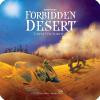
|
Forbidden Desert
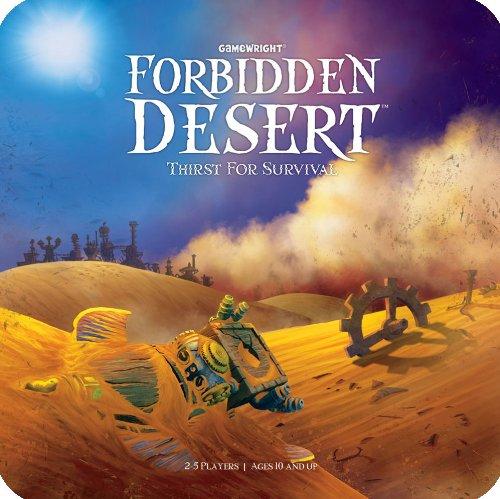
Gear up for a thrilling adventure to recover a legendary flying machine buried deep in the ruins of an ancient desert city. You'll need to coordinate with your teammates and use every available resource if you hope to survive the scorching heat and relentless sandstorm. Find the flying machine and escape before you all become permanent artifacts of the Forbidden Desert! When we launched Forbidden Island in 2010, we had an inkling that we had created a hit game but never to the point that we'd be prompted to make a sequel. Well, here we are a few years later with just that in hand. Our challenge to designer Matt Leacock was to create a game that would contain familiar elements (cooperative play, modular board), while offering up a completely different in-game experience. In addition, we wanted it to be simultaneously approachable to new players while upping the ante for those who felt they had mastered Forbidden Island. All this resulted in a fresh new game with an innovative set of mechanics, such as an ever-shifting board, individual resource management, and unique method for locating the flying machine parts. Hopefully we've achieved our goals and quenched your thirst for adventure!
Minimum Age: 10
Minimum Players: 2
Maximum Players: 5
Boardgame Atlas: Link
|
Ceaco |
Adventure, Fantasy, Sci-Fi |
2013 |
1 |

|
Forbidden Island
Nominated for the 2011 Spiel des Jahres (Game of the Year) Award.
Dare to discover Forbidden Island! Join a team of fearless adventurers on a do-or-die mission to capture four sacred treasures from the ruins of this perilous paradise. Your team will have to work together and make some pulse-pounding maneuvers, as the island will sink beneath every step! Race to collect the treasures and make a triumphant escape before you are swallowed into the watery abyss!
Minimum Age: 10
Minimum Players: 2
Maximum Players: 4
Boardgame Atlas: Link
|
Gamewright |
Adventure, Fantasy |
2010 |
1 |

|
Formula D
Formula D transports you into the turbulent world of Formula 1: Don't lose control of the engine in the last bottleneck, master the chicane, stick to your opponent's back wheels, take advantage of the slipstream and then coolly overtake him ... A Formula 1 pilot has to be willing to take risks and be able to plan ahead - at least if you want to get to the very top of the winners' podium.
Formula D also means the suspense of illegal racing on the streets of the big cities. Anything goes: customized cars, nitro fuel injection, skidding in roundabouts, unfair tricks ... The game principles always stay the same, but different cars, rules and circuits come into play.
This new edition of Formula D contains material which has not yet been published, including painted cars, dashboards, driver profiles, circuits ... And simple playing instructions are enclosed, allowing you to start play immediately. Off you go!
Minimum Age: 10
Minimum Players: 2
Maximum Players: 10
Boardgame Atlas: Link
|
Asmodee Editions |
Racing, Sports |
2008 |
1 |

|
Fury of Dracula 3rd Edition
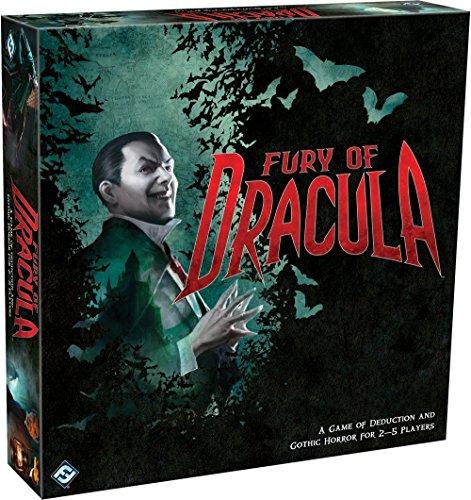
The most notorious vampire of all rises again in this third edition of Fury of Dracula, a board game of deduction and gothic horror based on Bram Stoker's classic novel. One player takes control of the legendary Count Dracula as he stealthily crosses Victorian-era Europe, spreading his diabolical vampirism everywhere he goes. Up to four other players govern Mina Harker and her determined companions as they try to locate and destroy the fiendish Count before he plunges Europe into horrific darkness. But in this heated game of cat and mouse, the hunted prey may also be preying on his hunters. Any day's travel might bring the hunters to Dracula's location. On any night the Count may attack. This edition features all-new art and graphic design crafted to complement the game's intuitive, thematic mechanics. Rounds are now broken into day and night: hunters take actions during both, but Dracula can only act at night. Combat is now more streamlined and decisive, and new rumor tokens allow Dracula to mislead hunters and extend the terrible reach of his influence. Count Dracula triumphs if he advances his influence track to thirteen; if the hunters can defeat him before then, they save the continent of Europe and win the game.
Minimum Age: 14
Minimum Players: 2
Maximum Players: 5
Boardgame Atlas: Link
|
Fantasy Flight Games |
Adventure, Deduction, Fighting, Horror, Novel-based |
2015 |
1 |

|
Gaia Project
"Set your sights on distant stars and strive to colonize the galaxy in Gaia project, the follow-up to the smash hit Terra Mystica! true to the foundations that made Terra Mystica a massive success, this box invites one to four players to forge their own galactic empires. Explore the vast reaches of space and convert planets to meet your faction unique environmental needs as you seek to tighten your grasp on the galaxy. Fourteen unique factions stand ready to boldly take their first steps into the cosmos while building structures to generate resources, researching new technology, and uniting planets to form powerful federations. Chart your course and remake planets as you see fit in Gaia project. In the end, only the most advanced faction will win."
Minimum Age: 14
Minimum Players: 1
Maximum Players: 4
Boardgame Atlas: Link
|
Z-Man Games |
Economic, Sci-Fi, Territory Building |
2017 |
1 |
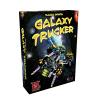
|
Galaxy Trucker
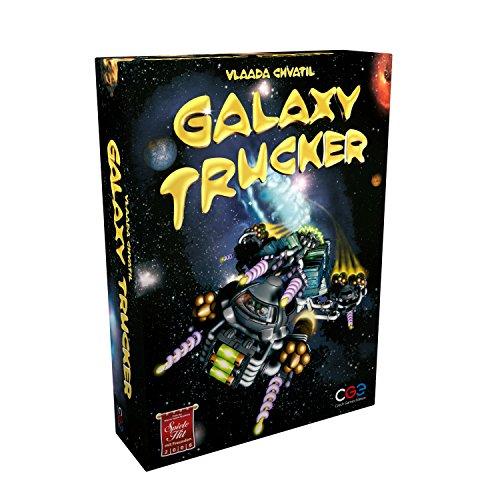
Corporation Incorporated is an interplanetary construction firm that builds sewer systems and low-income housing on the less-developed planets of the Galaxy. For years, Corp Inc. has tottered on the brink of bankruptcy: transporting building materials to the edge of the Galaxy, where the need for their services is greatest, is a risky business.
The company was saved by a few visionaries on the board of directors. Instead of shipping materials to the Periphery, they reasoned, why not build the materials into spacecraft and let them ship themselves? Furthermore, why hire pilots if there are nut-cases who will do it for free?
That's where you come in. Just sign the contract, and you gain unrestricted access to a Corp Inc. Warehouse. Build your own space ship from the available prefabricated components, and fly it to the Periphery. Of course, you may have to eat a loss, but any profits you make along the way are yours to keep, and Corporation Incorporated will pay you a bonus for quick delivery.
It's possible that you will end up with an insurmountable debt and finish your days panhandling on the streets of Deneb III, but if Lady Luck should smile upon you, you just might find yourself among the 10 billion richest people in the Galaxy!
Minimum Age: 14
Minimum Players: 2
Maximum Players: 4
Boardgame Atlas: Link
|
Czech Games Edition |
Humor, Puzzle, Sci-Fi, Transportation |
2007 |
1 |

|
Garden Dice

Garden Dice is a family strategy game that combines dice rolling, tile laying, and set collection. The game board depicts a garden as a 6x6 grid in which seed and vegetable tiles are placed using dice rolls as coordinates. Players take turns using the dice to plant, water, and harvest five different types of vegetables with differing point values, from the lowly squash to the mighty eggplant.
The game's chaining mechanism allows players to water or harvest multiple tiles using a single action, enabling players to build upon each others' chains. Players can also use bird and rabbit tiles to eat other players' seed and veggie tiles, but not without paying a small penalty. Two other special tiles – the sundial and the scarecrow – allow players to modify dice rolls or protect their own tiles.
The Gnome expansion included in Garden Dice can be added to the base game to give players the ability to adjust the dice rolls for purchasing, watering, and harvesting their vegetables, leading to a more strategic experience.
Bonuses increase the values of tiles as they are harvested, and additional points are awarded at the end of the game for collecting sets. The player with the most points when the last tile is taken wins.
Minimum Age: 13
Minimum Players: 2
Maximum Players: 4
Boardgame Atlas: Link
|
Flat River Group |
Dice, Farming |
2012 |
1 |

|
Ghost Blitz Board Game
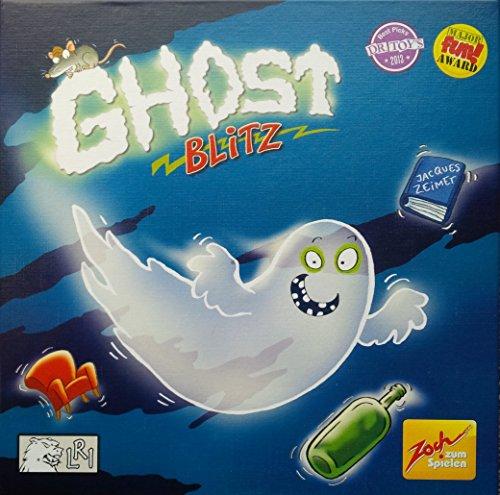
Balduin, the house ghost, found an old camera in the castle cellar. Immediately he photographed everything that he loves to make disappear when he is haunting including himself, of course. Unfortunately, the enchanted camera takes many photos in the wrong colors. Sometimes the green bottle is white, at other times it's blue. Looking at the photos, Balduin doesn't really remember any more what he wanted to make disappear next. Can you help him with his haunting and quickly name the right item, or even make it disappear by yourself? If you grab the right items quickly, you have a good chance of winning. In Geistesblitz, five wooden items sit on the table waiting to be caught: a white ghost, a green bottle, a cute grey mouse, a blue book and a comfortable red chair. Each card in the deck shows pictures of two objects, with one or both objects colored the wrong way. With all players playing at the same time, someone reveals a card, then players grab for the "right" object but which object is right? If one object is colored correctly say, a green bottle and a red mouse then players need to grab that correctly colored object. If both objects are colored incorrectly say, a green ghost and a red mouse then you look for the object and color not represented among the four details shown. In this case you see green, red, ghost and mouse, so players need to grab the blue book. The first player to grab the correct object keeps the card, then reveals the next card from the deck. If a…
Minimum Age: 8
Minimum Players: 2
Maximum Players: 8
Boardgame Atlas: Link
|
Lion Rampant Imports Ltd |
Action, Dexterity, Card Game, Children's Game, Real-time |
2010 |
1 |

|
Ginkgopolis
In Ginkgopolis, the city tiles come in three colors: yellow, which provides victory points; red, which provides resources; and blue, which provides new city tiles. Some tiles start in play, and they're surrounded by letter markers that show where new tiles can be placed.
On a turn, each player chooses a card from his hand simultaneously. Players reveal these cards, adding new tiles to the border of the city in the appropriate location or placing tiles on top of existing tiles. Each card in your hand that you don't play is passed on to your left-hand neighbor, so keep in mind how your play might set up theirs!
When you add a new tile to the city, you take a "power" card of the same color, and these cards provide you additional abilities during the game, allowing you to scale up your building and point-scoring efforts.
Minimum Age: 13
Minimum Players: 1
Maximum Players: 5
Boardgame Atlas: Link
|
Z-Man Games |
City Building, Environmental, Science Fiction, Territory Building |
2012 |
1 |

|
Ginkgopolis The Experts
The success of Ginkgopolis attracts all sorts of experts (artists, engineers, bankers,journalists.) who wish to profit from its success. Design competitions and advertising campaigns eventually lead to increasingly imposing avant-garde buildings. So imposing, in fact, that it becomes necessary to provide green spaces in order to maintain the air quality in this boomtown. And don't let the speed of construction cause you to forget ISO standards. an occasional inspection will set you straight!
Minimum Age: 13
Minimum Players: 2
Maximum Players: 5
Boardgame Atlas: Link
|
Z-Man Games |
City Building, Environmental, Expansion, Science Fiction, Territory Building |
2013 |
1 |

|
Giza: The Great Pyramid
Pharaoh is worried! His tomb at Giza is behind schedule, and he fears it will not be done in time for his funeral. He is offering great rewards to the faction that contributes the most work on his pyramid in the next ten years. If your people work the hardest and work the smartest you shall earn Pharaoh's favor!
In Giza: the Great Pyramid you are the leader of one of four factions vying for Pharaoh's favor. You have ten years to outperform the other factions and contribute the most to his great pyramid, earning eternal gratitude and glory. You shall need to balance your labor! Farm and fish to feed your people. Sweat and struggle with the back-breaking labor of moving the giant stone blocks into place. Task your folk with the creation of exquisite artworks to beautify Pharaoh's eternal rest.
Are you smart enough, organized enough and diligent enough to lead your people and earn Pharaoh's favor?
Minimum Age: 12
Minimum Players: 3
Maximum Players: 4
Boardgame Atlas: Link
|
Mayfair Games |
Ancient |
2012 |
1 |

|
Gods Love Dinosaurs
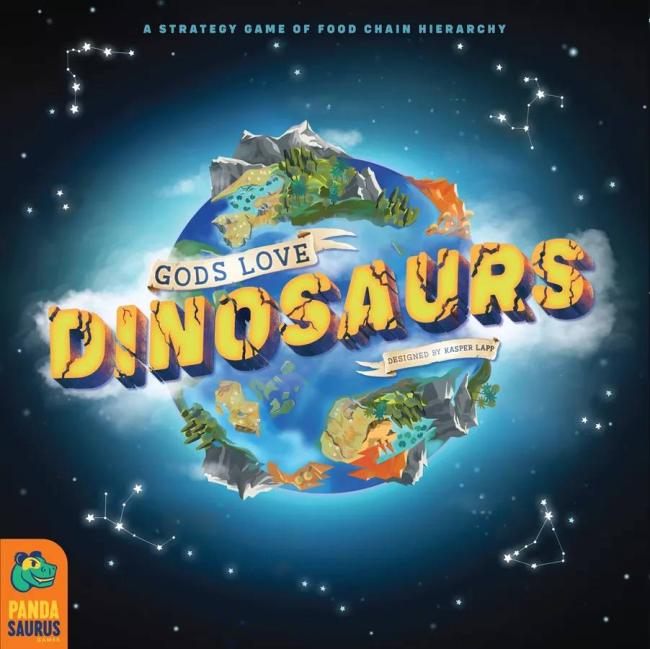
How do you make an ecosystem flourish with just enough of every life form in the chain to supply you with dinosaurs to dominate the lands? Resources are scarce, animals can go extinct in an area, and everyone must eat to survive — so moves must be cunning. Life hangs in the balance...
In Gods Love Dinosaurs, a cheeky, wild, and timeless take on the scientific tale as old as life itself, you are a god who has been tasked with designing an ecosystem with a sustainable food chain of predator and prey animals. But you just love dinosaurs, so all you really want to do is to make as many of them as possible!
Each turn, you'll add one tile to your ecosystem, which will add new animals and give them room to grow. Every so often, your dinosaurs will tromp around your ecosystem eating all the animals. The more they eat, the more eggs they lay — and the more points you score! Just be careful not to overeat, or there won't be enough food to keep your dinosaurs alive the next time.
Minimum Age: 10
Minimum Players: 2
Maximum Players: 5
Boardgame Atlas: Link
|
Pandasaurus Games |
Abstract, Animals, Prehistoric, Puzzle |
2020 |
1 |
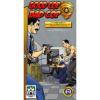
|
Good Cop Bad Cop
Good Cop Bad Cop is a hidden identity, bluffing, and deduction game about a corrupted police district.
Corruption has infiltrated your agency. The Kingpin must be taken down before the crooked cops take out the Agent. You won't be able to do it alone, but there's no knowing who's honest and who's crooked. Do some investigating to discover who's who, but act fast; there aren't enough guns for everyone!
Good Cop Bad Cop plays 4-8 players, can be learned and played in 10 to 20 minutes, and is suitable for ages 12+. It comes with 54 cards, each with a linen finish, in a tuck box.
Minimum Age: 12
Minimum Players: 4
Maximum Players: 8
Boardgame Atlas: Link
|
Overworld Games |
Bluffing, Card Game, Deduction, Party Game, Spies/Secret Agents |
2014 |
1 |

|
Gorus Maximus
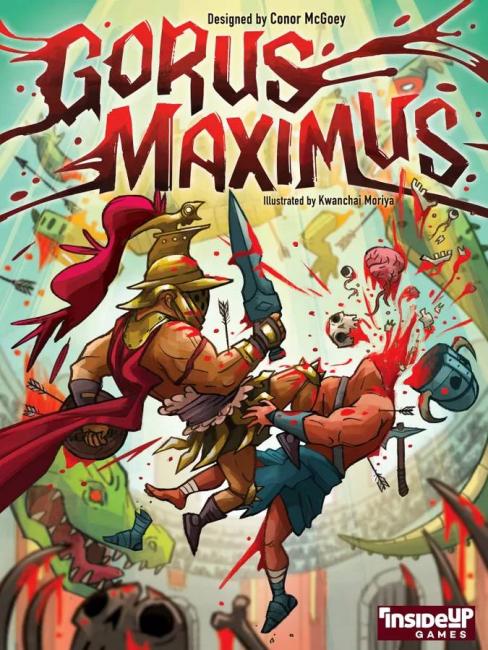
Gorus Maximus is a bloody trick-taking game of gladiatorial combat in which the trump suit can change mid-trick! The game can be played "player vs. player" or in teams.
Dispatch your strongest gladiators and most ferocious beasts to earn crowd favor! Match the rank of the last gladiator played, and the trump suit changes immediately!
Players are dealt a hand of ten gladiator cards and must contribute one gladiator to each bout (trick). There is a preferred school (trump suit) and the strongest gladiator from this school wins the bout. If no preferred gladiator entered the fight, then the strongest initiating gladiator (suit called for) wins. Players must follow the initiating school if possible, or they may "challenge" by matching the strength of the last gladiator played, immediately changing the preferred school to that of their gladiator!
Players compete to collect gladiators with positive crowd favor and avoid those with negative favor. The player with the highest favor at the end of the round earns 1 crowd support. The first player to earn 3 crowd support has won the support of the masses and earns the title: Champion of Gorus Maximus!
Minimum Age: 13
Minimum Players: 1
Maximum Players: 8
Boardgame Atlas: Link
|
Inside Up Games |
Card Game |
2018 |
1 |

|
Gravwell: Escape from the 9th Dimension
After being pulled through a black hole, four spaceships find themselves in a dimension with physics never before encountered and without fuel. By mining and collecting basic elements from the space dust and asteroids in the area, you can muster just enough thrust to move your ship. But in this bizarre dimension, gravity is not working like how you've been taught. Your ship will typically travel towards the nearest object... which is usually another ship... and those ships are moving. Sometimes forwards, and sometimes backwards.
Time is running out to save your crew and your ship! As a grim reminder of the cost of failing to escape, the frozen hulks of dead spacecraft litter the escape route. But with careful cardplay, you can slingshot past these derelict craft and be the first to escape from the Gravwell
Minimum Age: 12
Minimum Players: 1
Maximum Players: 4
Boardgame Atlas: Link
|
Renegade Game Studios |
Card Game, Science Fiction |
2013 |
1 |

|
Great Western Trail
America in the 19th century: You are a rancher and repeatedly herd your cattle from Texas to Kansas City, where you send them off by train. This earns you money and victory points. Needless to say, each time you arrive in Kansas City, you want to have your most valuable cattle in tow. However, the "Great Western Trail" not only requires that you keep your herd in good shape, but also that you wisely use the various buildings along the trail. Also, it might be a good idea to hire capable staff: cowboys to improve your herd, craftsmen to build your very own buildings, or engineers for the important railroad line.
If you cleverly manage your herd and navigate the opportunities and pitfalls of Great Western Trail, you surely will gain the most victory points and win the game.
Minimum Age: 12
Minimum Players: 2
Maximum Players: 4
Boardgame Atlas: Link
|
Eggertspiele |
American West, Animals |
2016 |
1 |
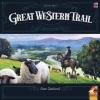
|
Great Western Trail: New Zealand
In Great Western Trail: New Zealand, you are a runholder — that is, the owner of a sheep station — on the South Island of New Zealand at the end of the 19th century. Recent years have seen your family farm prosper by diversifying your breeds of sheep and by increasing the value of your wool.
With the dawn of the new century, new challenges have arisen. You must acquire new and improved breeds of sheep to ensure the prosperity of your family business and the laborers who work for you.
Minimum Age: 12
Minimum Players: 1
Maximum Players: 4
Boardgame Atlas: Link
|
Eggertspiele |
Animals, Economic |
2023 |
1 |
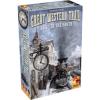
|
Great Western Trail: Rails to the North
From Board Game Geek: Great Western Trail: Rails to the North introduces a new railway system for players to compete on as they grow their cow herding businesses.
With this expansion, players deliver their herds to northeast United States with stops in Chicago, Detroit, and New York City, amongst other cities, in an effort to become the most successful cow rancher this side of the Mississippi. Be advised that business is much more difficult on this rail, so players will want to take advantage of friendly hospitality by establishing branchlets and helping form towns. In addition to the new railway system, players will also discover new station master tiles, private buildings, and an expanded player board to offer more strategic depth in their decision making.
Minimum Age: 14
Minimum Players: 2
Maximum Players: 4
Boardgame Atlas: Link
|
Eggertspiele |
American West, Expansion |
2018 |
1 |

|
Gridstones
Gridstones is an elegant, gripping game of strategy and visualization.
Designed by Toronto native Tim W. K. Brown, this critically-acclaimed abstract strategy and puzzle game is quick, fun, easy-to-learn and great for the whole family.
Simply place or remove STONES on or from the GRID to create a match to the cards in your hand - but be careful, your opponents will be trying to match their cards too, and the grid will change with every turn.
So if you’re up to the challenge, grab a friend, or six, and get hooked on this engaging, strategic game of pattern matching.
Minimum Age: 7
Minimum Players: 2
Maximum Players: 7
Boardgame Atlas: Link
|
CSE Games |
Abstract, Card Game, Puzzle |
2008 |
1 |
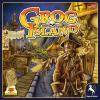
|
Grog Island
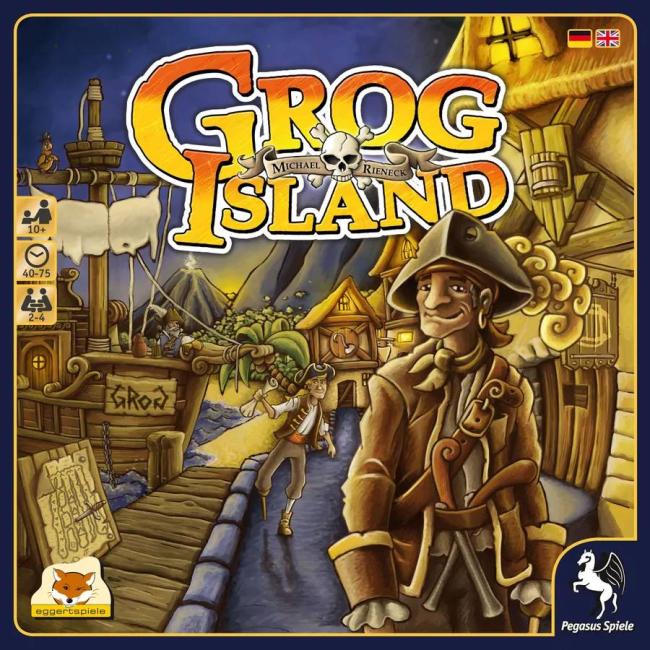
Even for the mightiest pirates there comes a time when they must retire from their lives of invading and plunder — but what's coming afterward? Well, on the five peninsulas of Grog Island, they can invest their loot in rock-solid businesses, such as peg-leg shops, carpentries for figureheads, workshops for voodoo dolls, or the infamous "Grog Hole" pub.
The core of Grog Island is its unique auction mechanism, which uses five colored dice. The players use these dice and the pips on them to create and raise bids. While the winner of an auction can claim buildings on certain peninsulas, the players who have passed are also rewarded: Not only do they receive goods like grog bottles or treasure maps but they also visit merchant ships where they can trade these goods for money, parrots or treasure chests. The auction mechanism of Grog Island makes for tactical and interesting gameplay as in certain moments, passing can be almost as rewarding as winning an auction. Finding the right balance between bidding and backing out is the key to winning.
The game ends as soon as one player has claimed a certain number of buildings, then all players score the secret goal cards they received both at the start of and during the game. These cards may give points for majorities on peninsulas as well as for claiming certain types of buildings or collecting certain goods. The player with the most points wins.
Minimum Age: 10
Minimum Players: 2
Maximum Players: 4
Boardgame Atlas: Link
|
Arclight |
Dice, Economic, Pirates |
2014 |
1 |

|
Hanabi
Winner of the prestigious Spiel des Jahres Award for 2013.
From 7 Wonders designer Antoine Bauza comes this innovative, cooperative card game where players race against the clock to build a dazzling fireworks finale. Trouble is, you can see the cards that everyone holds - except your own!
Working together, players exchange vital information in order to play their cards in the proper launch sequence. Build and light each firework correctly to win the game and avoid a fizzling fiasco!
Minimum Age: 8
Minimum Players: 2
Maximum Players: 5
Boardgame Atlas: Link
|
R and R Games |
Card Game, Deduction |
2010 |
1 |
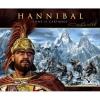
|
Hannibal: Rome vs. Carthage
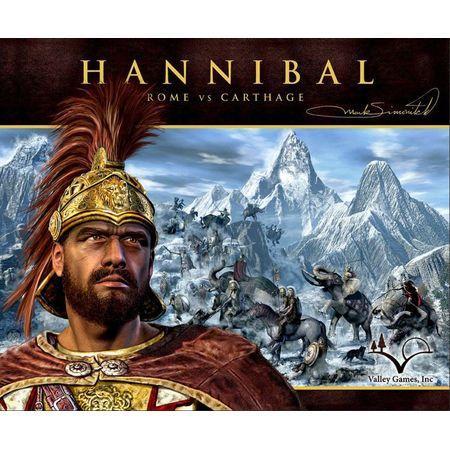
This game uses the very popular card system which first appeared in Avalon Hill's We the People game to detail the struggle between Carthage's Hannibal and the Roman Republic in approximately 200 BC.
Hannibal: Rome vs. Carthage is an asymmetrical card driven game for 2 players set in times of epic struggle between ancient Rome and Carthage. It presents a conflict between two super-powers of Antiquity from classical Clausewitzian perspective, according to which a power only reverts to military operations when there is no other way to achieve the goal: political dominance.
Hannibal: Rome vs. Carthage has been designed by one of the most acclaimed designers in the World, Mark Simonitch. Players use Strategy Cards for multiple purposes: moving generals, levying new troops, reinforcing existing armies, gaining political control of the provinces involved in the war, and introducing historical events. When two armies meet on the battlefield, a second set of cards, called Battle Cards, are used to determine the winner. Ultimately both players seek victory by dominating both fronts: military and political.
Minimum Age: 12
Minimum Players: 2
Maximum Players: 2
Boardgame Atlas: Link
|
Valley Games |
Ancient, Political, Wargame |
1996 |
1 |

|
Happy City
Do you have what it takes to grow a city from a humble market to a thriving mini-metropolis? Collect 10 buildings and make sure your citizens are happy with the place they live in!
Happy City includes rules for two ways to play: a family version and an "expert version" that features more interaction and strategy.
Minimum Age: 10
Minimum Players: 2
Maximum Players: 5
Boardgame Atlas: Link
|
Cocktail Games |
Children's Game, City Building, Territory Building |
2021 |
1 |

|
Harbour
Harbour is a worker placement game where players move their worker from building to building, collecting and trading Fish, Livestock, Wood, and Stone; and cashing those resources in to purchase buildings (which are the worker placement spots) from the central pool. Once a building is purchased, it is replaced from the deck, and the central pool is a small subset of the deck, and is therefore different every game.
The game ends when a player has purchased his fourth building. After that round finishes, the player with the most points worth of buildings is the winner!
At the heart of Harbour is a dynamic market mechanism. Each time a player purchases a building, the value of the resources they used drops, while the value of the other resources rise. You'll have to carefully time your purchases to take advantage of the ebb and flow of market prices, or be prepared to waste some resources!
Minimum Age: 10
Minimum Players: 1
Maximum Players: 4
Boardgame Atlas: Link
|
Tasty Minstrel Games |
City Building, Economic, Fantasy, Humor |
2015 |
1 |
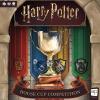
|
Harry Potter: House Cup Competition
Welcome to another year at Hogwarts School of Witchcraft and Wizardry! The House Cup calls for the brightest students to compete in this worker-placement strategy game. In Harry Potter: House Cup Competition, use gained knowledge and magic to learn lessons and complete challenges. Players send iconic characters like Harry Potter, Cedric Diggory, Cho Chang, and Draco Malfoy out on the game board to enhance their skills. The player who earns the most points for their House will be named the House Cup Champion!
Minimum Age: 11
Minimum Players: 2
Maximum Players: 4
Boardgame Atlas: Link
|
The Op |
Fantasy, Novel-based |
2020 |
1 |

|
Heaven & Ale
You have been assigned to lead an ancient monastery and its brewery. Now it's your time to brew the best beer under God's blue sky!
The fine art of brewing beer demands your best timing. In order to get the best results of your production, you have to provide your cloister's garden with fertile resources and the right number of monks helping with the harvest - but keep your brewmaster in mind as he is ready and eager to refine each and every one of your barrels!
In Heaven & Ale, you have to overcome the harsh competition of your fellow players. There is a fine balance between upgrading your cloister's garden and harvesting the resources you need to fill your barrels. Only those who manage to keep a cool head are able to win the race for the best beer!
Minimum Age: 12
Minimum Players: 2
Maximum Players: 4
Boardgame Atlas: Link
|
Eggertspiele |
Economic, Farming, Industry/Manufacturing |
2017 |
1 |
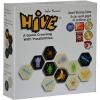
|
Hive
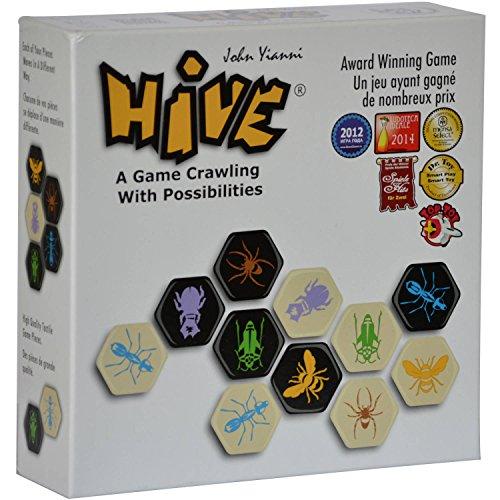
Hive is a boardless, strategic game for 2 players ages 8 and up. The object of the game is to surround your opponent's queen bee while trying to block your opponent from doing the same to your queen bee.
Each player has 11 tiles, all in all, representing 5 different insects. The players take turns, either choosing to add a tile to the hive or moving a tile in the hive.
Each tile has a unique way of moving (like in chess) and resembles the movement of the insect depicted on the tile. For instance, the grasshopper is the only tile which can jump.
Hive is a fun game to play because of its simple rules, yet challenging for its depth. Hive enhances each player's skills of strategic planning, tactical thinking and spatial vision. To win, you must play both the offense (surround your opponent's bee) and the defense (to protect your queen bee).
A nice decorative storage bag makes it easy to carry, store and play anywhere.
Minimum Age: 8
Minimum Players: 2
Maximum Players: 2
Boardgame Atlas: Link
|
Gen Four Two Games |
Abstract, Strategy |
2001 |
2 |
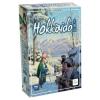
|
Hokkaido
After establishing themselves in Honshu, the Lords and Ladies head north to Hokkaido. Beholding Hokkaido's mountainous landscape, they see that expansion on this land will prove to be a greater challenge than before. Hokkaido is the second map-building card game in the Nippon series, bringing new ideas and drafting mechanisms to the first design, Honshu. A game of Hokkaido consists of 12 rounds, each divided into two separate phases. Each player must expand their personal map to maximize their scoring possibilities.
Minimum Age: 8
Minimum Players: 2
Maximum Players: 5
Boardgame Atlas: Link
|
Lautapelit.fi |
Card Game, City Building, Territory Building |
2018 |
1 |

|
Ideology: 2nd Edition
Ideology is a 2-5 player game where each player symbolizes one of the 20th Century's most powerful Ideologies -- Capitalism, Islamic Fundamentalism, Imperialism, Communism, or Fascism. Starting with one global region completely under its sway, each Ideology attempts to influence and control the independent regions of the earth.
Each Ideology will use economic, cultural, and military influence to bring countries under control. If a player has influence in a country in which you have influence, you can both engage in economic, cultural, and military conflict (depending on your diplomatic stance toward each other) to knock out your opponent's influence. You can also purchase Advancements like Propaganda, Tactics, etc. to make it harder for an opponent to conflict you or to make it easier for you to influence a country.
The goal is to posses a Global Influence of 12 or more.
Minimum Age: 12
Minimum Players: 2
Maximum Players: 5
Boardgame Atlas: Link
|
Z-Man Games |
Political |
2003 |
1 |
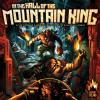
|
In the Hall of the Mountain King
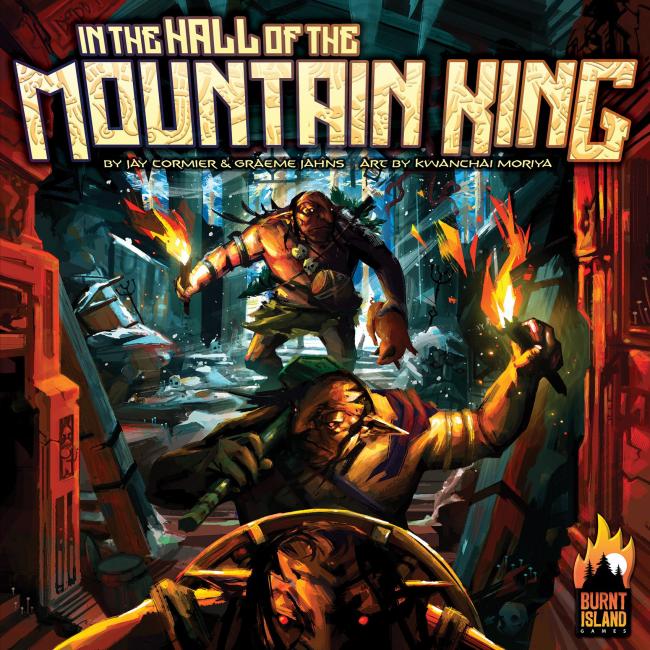
Play as trolls rebuilding your abandoned kingdom under the mountain in In the Hall of the Mountain King. With muscle and magic, you'll unearth riches, dig out collapsed tunnels, and carve out great halls as you raise the toppled statues of your ancestors to their places of honor at the heart of the mountain. Gameplay is driven by the innovative cascading production system. Timing and tactics are key as you work to restore your home to its former glory and win the crown!
Working on the same game board with the other players (but beginning at your own entrance), you'll dig a competing network of tunnels by spending increasingly valuable materials to lay polyomino tiles onto the map. You want to extend your tunnels to connect with buried gold and materials, with workshop locations that can transform resources, and especially with toppled statues. Statues are key to scoring, and you'll spend carts to move them through the tunnels to prime scoring locations near the heart of the mountain.
A major aspect of the game is the cascading production. You begin with a line of four trolls, and every troll shows the combination of resources — gold, stone, iron, marble, carts, runes, and hammers — that it produces. When a new troll is hired, place it above two other trolls, forming a "pyramid". The new troll activates, gaining its resources, and any trolls beneath it ALSO activate, gaining any resources that they have room to carry. In this way…
Minimum Age: 12
Minimum Players: 2
Maximum Players: 5
Boardgame Atlas: Link
|
Burnt Island Games |
Fantasy, Territory Building |
2019 |
1 |

|
In the Year of the Dragon
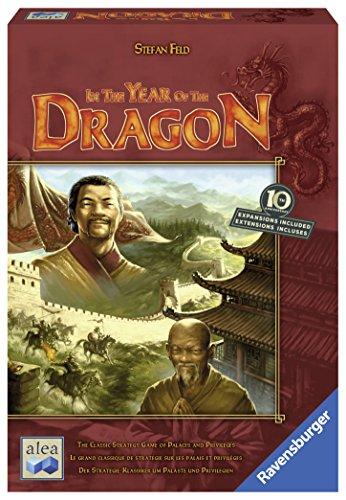
Players take on the role of Chinese rulers around the year 1000. The game plays out in twelve rounds, with each round representing one month in a year that seems to go from bad to worse. Disease, drought, and attacks from the Mongols may claim lives, but make sure you have enough money to offer a tribute to the Emperor.
The game play is easier than it may appear. Every player has a set of "person" cards. Each round, you choose one action (most of which call on your workers' abilities) to help you prepare for the months ahead. Then you play one person card, recruiting that person and placing him into one of your palaces. Each person brings different skills and abilities to help you ride out the year. (Farmers help you gain rice to survive a drought month, Tax Collectors raise money, etc.) At the end of each round, that month's event is triggered, which may cost you some of your workers, some money, or give you points.
Careful planning is the key to surviving "the year of the dragon," but survival alone may not win you the game.
Minimum Age: 12
Minimum Players: 2
Maximum Players: 5
Boardgame Atlas: Link
|
Alea |
Economic, Medieval |
2007 |
1 |

|
In too Deep

In Too Deep is a unique, narrative that thrusts you into the future in a tense, strategic board game for 1-5 players. Draft characters and spend actions to complete objectives and collect sets. What side of the law will you end up on?
In the year 2087, central governments have fallen. What remains are fragmented citystates like New Dawn City, struggling to keep chaos at bay. The sinister Syndicate targets these weakened cities for domination by usurping, organizing, and enhancing the existing criminal elements. In the world of In Too Deep, you are part of a secret agency dedicated to stopping the Syndicate at all costs.
Cybernetic implants give Syndicate operatives a technological advantage, but you have found a way to exploit that power. By infiltrating their cerebral upgrades, you can gain control of these criminals. Going deep undercover into the minds of your targets, you’ll coordinate crimes of escalating seriousness to get your hands on the critical evidence needed to foil the Syndicate’s looming plot.
Each turn, you can hook into a new criminal and manipulate their activities throughout the city, accessing powerful skills and increased stamina as you grow familiar with their minds. Your physical body is in a secret lab far from the actual action, but you are by no means safe. Entering the mind of criminals takes its toll on your morality.
Orchestrate crimes, strive to put the information you gather to the…
Minimum Age: 14
Minimum Players: 1
Maximum Players: 4
Boardgame Atlas: Link
|
Burnt Island Games |
Adventure, Science Fiction, Spies/Secret Agents |
2021 |
1 |

|
Inca Empire
In Inca Empire, each player is an "Apu," or leader of one of the four regions ("suyus"). Your job as an Apu is to increase your status in the eyes of the divine emperor ("Sapa Inca") by doing the best job of expanding and improving the empire. Each Apu begins with the manpower of their region. They build roads and conquer neighboring regions, increasing the manpower and resources available to them. Apus are rewarded for each new region they add to the empire and for improvements such as terraces, garrisons, cities, and temples.
The player who has the most victory points (VP) at the moment Pizarro arrives at the Inca capital of Cuzco wins the game.
Note: Due to the highly interactive nature of the Sun card placement, Inca Empire cannot be played with only two players.
Inca Empire is a re-implementation of Tahuantinsuyu.
Minimum Age: 12
Minimum Players: 3
Maximum Players: 4
Boardgame Atlas: Link
|
Z-Man Games |
Civilization, Exploration |
2010 |
1 |

|
Infinite City

Infinite City is a standalone tile game in which players become the leaders of corporations building an ever-sprawling city, maneuvering to control the largest districts while holding on to the most valuable buildings.
Infinite City uses tiles to represent buildings, and colored pegs to represent control by players. The tiles are mixed, five tiles are dealt to each player, and five tiles are placed face down in the shape of a cross at the center of the play area. On their turns, players play a tile face up adjacent to one of the five starting tiles or a previously played tile, play one of their colored pegs on the tile, and follow the instructions on the tile. These instructions may lead to playing additional tiles, drawing tiles, moving tiles previously played, turning face down tiles face up, taking tiles from opponents, preventing actions or even exchanging hands of tiles with other players. When players finish their turns, if they have less than five tiles in their hands, they draw additional tiles so that they end their turn with at least five tiles.
The game ends when one player places the last of his colored pegs, or the fifth Power Station tile is played. Each player is awarded points for contiguous groups of at least three tiles controlled by him at a rate of one point per tile. Some tiles have a point value number in the corner; players receive the number of points indicated for such tiles that they control. Also, some…
Minimum Age: 10
Minimum Players: 2
Maximum Players: 6
Boardgame Atlas: Link
|
Alderac Entertainment Group |
City Building, Science Fiction, Territory Building |
2009 |
1 |
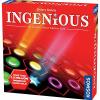
|
Ingenious
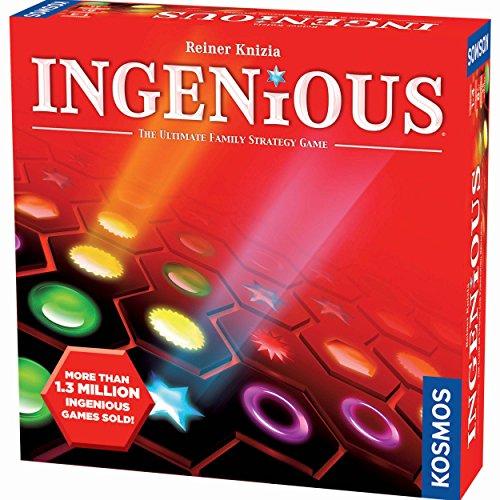
Think outside the square! Ingenious is an abstract tile-placement game in which the players take turns placing tiles in the shape of two connected hexagons into a hexagonal grid on the board. Each tile has two colored symbols on it. Players earn points in a specific color for each line of matching colored symbols that they extend when they place a tile. A player's final score is determined by his or her lowest scoring color, not the highest. The winner is the player whose lowest score is the highest compared to the other players' lowest scores, and not the player with the highest scoring color overall.
The game includes 120 domino-style tiles, each consisting of two hexagons connected along one side. Each hexagon has one of six colored symbols in it, with most tiles having two different colored symbols and some having two of the same colored symbol. Each player has a rack with six tiles on it. During his or her turn, each player places one tile from his or her rack onto two empty hexagonal spaces on the game board. For each of the two hexagons composing this tile, the player scores one point in the hexagon's color for each already-placed hexagon of the same color that radiates outward in a straight line from one of the placed hexagon's five sides. If a player's score in a color reaches 18, he or she immediately takes another turn. At the end of the turn, the player refills his or her rack to six tiles.
When no more tiles can be placed on the game…
Minimum Age: 10
Minimum Players: 1
Maximum Players: 4
Boardgame Atlas: Link
|
Thames & Kosmos |
Abstract |
2004 |
1 |

|
Inis
The game's elegant mechanics combine card drafting and area control to produce a system rich in strategic options and interpersonal interactions.
At the same time, brilliantly crafted tiles give every game a unique, gradually unfolding geography. The gorgeous original art brings Ireland's ancient epics and audacious heroes to life.
There are three different types of cards in Inis:
Action Cards - These are drafted each round and provide the base actions to deploy troops, move troops, attack, and play new regions.
Advantage Cards - These are acquired as a result of controlling certain regions. Each region has its own Advantage Card you receive as a result of having the most troops in it.
Epic Tales Cards - These unique and powerful cards evoke the Celtic gods and heroes to inspire the clans to accomplish legendary feats.
Minimum Age: 14
Minimum Players: 2
Maximum Players: 4
Boardgame Atlas: Link
|
Asmodee Editions |
Ancient, Card Game, Mythology |
2016 |
1 |

|
Innovation
This game by Carl Chudyk is a journey through innovations from the stone age through modern times. Each player builds a civilization based on various technologies, ideas, and cultural advancements, all represented by cards. Each of these cards has a unique power which will allow further advancement, point scoring, or even attacking other civilizations. Be careful though, as other civilizations may be able to benefit from your ideas as well!
To win, you must score achievements, which you can attain by amassing points or by meeting certain criteria with the innovations you have built. Plan your civilization well, and outmaneuver your opponents, and with some luck you will achieve victory!
Minimum Age: 12
Minimum Players: 2
Maximum Players: 4
Boardgame Atlas: Link
|
IELLO |
Card Game |
2010 |
1 |
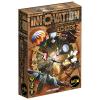
|
Innovation: Echoes Expansion
Civilizations have never competed so fiercely to leave their mark on history! Add a fifth player, new Innovations, and effects that bring even more unexpected developments to your games!
Benefit from past abilities thanks to Echo effects, gain Influence directly through your Innovations, and anticipate the discovery of Innovations by researching cards from upcoming Periods.
Contents:
105 Innovation Cards
5 Domain Cards
1 Set of Rules
Minimum Age: 14
Minimum Players: 2
Maximum Players: 2
Boardgame Atlas: Link
|
IELLO |
Card Game, Civilization, Expansion |
2011 |
1 |
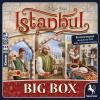
|
Istanbul: Big Box
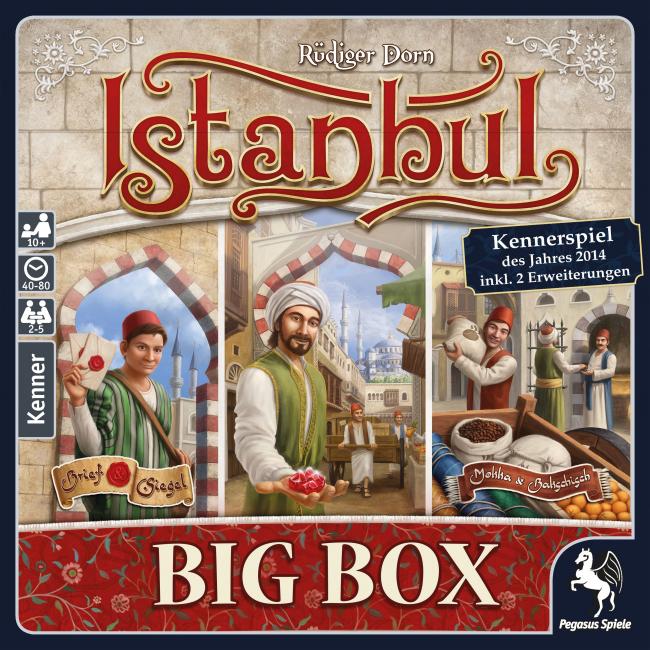
In Istanbul, you lead a group of one merchant and four assistants through 16 locations in the bazaar. At each such location, you can carry out a specific action. The challenge, though, is that to take an action, you must move your merchant and an assistant there, then leave the assistant behind (to handle all the details while you focus on larger matters). If you want to use that assistant again later, your merchant must return to that location to pick him up. Thus, you must plan ahead carefully to avoid being left with no assistants and thus unable to do anything...
In more detail, on a turn you move your merchant and his retinue of assistants one or two steps through the bazaar, either leave an assistant at that location or collect an assistant left earlier, then perform the action. If you meet other merchants or certain individuals at the location, you might be able to take a small extra action. Possible actions include:
- Paying to increase your wheelbarrow capacity, which starts the game with a capacity of only two for each good.
- Filling your wheelbarrow with a specified good to its limit.
- Acquiring a special ability, and the earlier you come, the easier they are to collect.
- Buying rubies or trading goods for rubies.
- Selling special combinations of goods to make the money you need to do everything else.
When a merchant has collected five rubies in his wheelbarrow,…
Minimum Age: 10
Minimum Players: 2
Maximum Players: 5
Boardgame Atlas: Link
|
Pegasus Spiele |
Economic |
2018 |
1 |

|
Jaipur
Jaipur, capital of Rajasthan. You are one of the two most powerful traders in the city.
But that's not enough for you, because only the merchant with two Seals of Excellence will have the privilege of being invited to the Maharaja's court.
You are therefore going to have to do better than your direct competitor by buying, exchanging and selling at better prices, all while keeping an eye on both your camel herds.
A card game for two seasoned traders!
Minimum Age: 12
Minimum Players: 2
Maximum Players: 2
Boardgame Atlas: Link
|
Asmodee Editions |
Card Game |
2009 |
1 |



















































